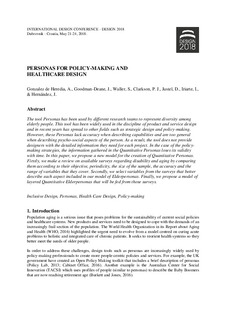
View/
Title
Personas for policy-making and healthcare designxmlui.dri2xhtml.METS-1.0.item-contributorOtherinstitution
https://ror.org/013meh722Version
http://purl.org/coar/version/c_970fb48d4fbd8a85
Access
http://purl.org/coar/access_right/c_abf2Publisher’s version
https://doi.org/10.21278/idc.2018.0438Published at
DS 92: Proceedings of the DESIGN 2018 15th International Design Conference Pp. 2645-2656. Editors, Marjanović D. et al. University of Zagreb, 2018Publisher
University of ZagrebKeywords
Inclusive DesignPersonas
Healthcare Design
Policy-making
Abstract
The tool Personas has been used by different research teams to represent diversity among elderly people. This tool has been widely used in the discipline of product and service design and in recent ye ... [+]
The tool Personas has been used by different research teams to represent diversity among elderly people. This tool has been widely used in the discipline of product and service design and in recent years has spread to other fields such as strategic design and policy-making. However, these Personas lack accuracy when describing capabilities and are too general when describing psycho-social aspects of the person. As a result, the tool does not provide designers with the detailed information they need for each project. In the case of the policy-making strategies, the information gathered in the Quantitative Personas loses its validity with time. In this paper, we propose a new model for the creation of Quantitative Personas. Firstly, we make a review on available surveys regarding disability and aging by comparing them according to their objective, periodicity, the size of the sample, the accuracy and the range of variables that they cover. Secondly, we select variables from the surveys that better describe each aspect included in our model of Elderpersonas. Finally, we propose a model of layered Quantitative Elderpersonas that will be fed from those surveys. [-]





















